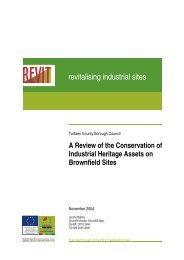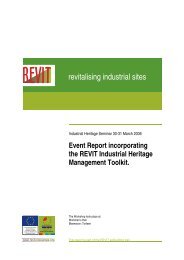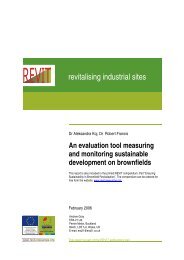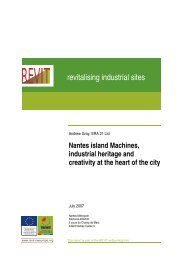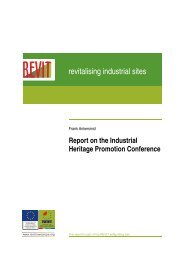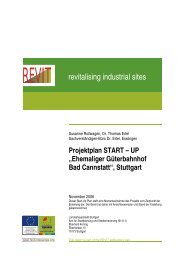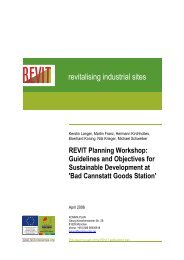Ensuring Sustainability in Brownfield Revitalisation as PDF
Ensuring Sustainability in Brownfield Revitalisation as PDF
Ensuring Sustainability in Brownfield Revitalisation as PDF
Create successful ePaper yourself
Turn your PDF publications into a flip-book with our unique Google optimized e-Paper software.
Insight <strong>in</strong>to CO2 reduction<br />
In the Netherlands, municipalities and prov<strong>in</strong>ces have made agreements with<br />
the state with respect to eligibility for the BANS Climate Covenant subsidy<br />
scheme. These agreements are translated <strong>in</strong>to reduction objectives for the<br />
emission of greenhouse g<strong>as</strong>es (ma<strong>in</strong>ly CO2). GPR® makes it simple to monitor<br />
the objectives by explicitly display<strong>in</strong>g the CO2 emissions that can be<br />
attributed to the project. If the CO2 emissions threaten to exceed the<br />
objectives allocated to the project, then the designer can attempt to<br />
improve this by mak<strong>in</strong>g changes <strong>in</strong> the Energy and Materials modules.<br />
The Overview W<strong>in</strong>dow shows the CO2 reduction<br />
<strong>in</strong> the bottom left-hand corner [Figure 5]. The<br />
relative data is shown. The reduction <strong>in</strong> CO2<br />
gives an impression of how well or badly the<br />
build<strong>in</strong>g scores with respect to a reference<br />
build<strong>in</strong>g. If the annual CO2 emission per m 2<br />
build<strong>in</strong>g is the same <strong>as</strong> that of the reference<br />
build<strong>in</strong>g, then the reduction is 0%. If the<br />
percentage reduction is greater than 0% then<br />
the design h<strong>as</strong> a good score. If the percentage<br />
Figure 5: Insight <strong>in</strong>to the CO2 reduction (relative)<br />
is negative, optimisation is probably required.<br />
Because the total is also subdivided <strong>in</strong>to Energy and Materials, it can be<br />
immediately seen where the improvement is likely to be found.<br />
For office and educational build<strong>in</strong>gs only one reference type h<strong>as</strong> been <strong>in</strong>cluded.<br />
There are eight possible reference types for hous<strong>in</strong>g, each of which h<strong>as</strong> a<br />
different reference value for the CO2 emissions. By select<strong>in</strong>g the reference <strong>in</strong><br />
the Overview W<strong>in</strong>dow [Figure 5], the project score is automatically compared to<br />
the correct reference.<br />
In addition to the relative scores, the absolute<br />
scores <strong>in</strong> kg CO2 per m 2 per year can also be<br />
found <strong>in</strong> the Energy and Materials modules<br />
[Figures 6 and 7]. These data can be useful if<br />
there are objectives formulated <strong>in</strong> terms of<br />
absolute CO2 emissions.<br />
Conclusion<br />
Figure 6: The bottom right-hand corner giv<strong>in</strong>g an <strong>in</strong>dication of the CO2<br />
emissions for the Energy module<br />
Figure 7: The bottom right-hand corner giv<strong>in</strong>g an <strong>in</strong>dication of the CO2<br />
emissions for the Materials module<br />
The susta<strong>in</strong>able build<strong>in</strong>g tool (GPR) is a specific tool to me<strong>as</strong>ure the<br />
susta<strong>in</strong>able development performance of new build<strong>in</strong>gs. Targets for different<br />
levels of susta<strong>in</strong>able development achievement (water, energy, material-use,<br />
w<strong>as</strong>te, health, and liv<strong>in</strong>g quality) are set and agreed between a municipality<br />
and a developer at the outset. As a new build<strong>in</strong>g is be<strong>in</strong>g designed, data can<br />
be fed <strong>in</strong>to the GPR tool to determ<strong>in</strong>e whether or not the build<strong>in</strong>g is meet<strong>in</strong>g<br />
the required standard. The tool can also suggest new technologies or<br />
materials to improve susta<strong>in</strong>able development performance. Once the build<strong>in</strong>g<br />
h<strong>as</strong> been designed and h<strong>as</strong> met its obligations us<strong>in</strong>g the tool, it can be given<br />
a consumer star rat<strong>in</strong>g for performance, similar to that awarded for<br />
w<strong>as</strong>h<strong>in</strong>g mach<strong>in</strong>es. Dur<strong>in</strong>g the construction ph<strong>as</strong>e, checks and tests are<br />
undertaken to determ<strong>in</strong>e whether or not the build<strong>in</strong>g cont<strong>in</strong>ues to meet its<br />
goals. Information from these checks help to update the tool and verify<br />
performance. F<strong>in</strong>ally, once the build<strong>in</strong>g h<strong>as</strong> been completed it can bo<strong>as</strong>t of its<br />
susta<strong>in</strong>able development performance criteria, add<strong>in</strong>g value to its market<br />
rate and help<strong>in</strong>g a municipality achieve its susta<strong>in</strong>able development targets.<br />
26



